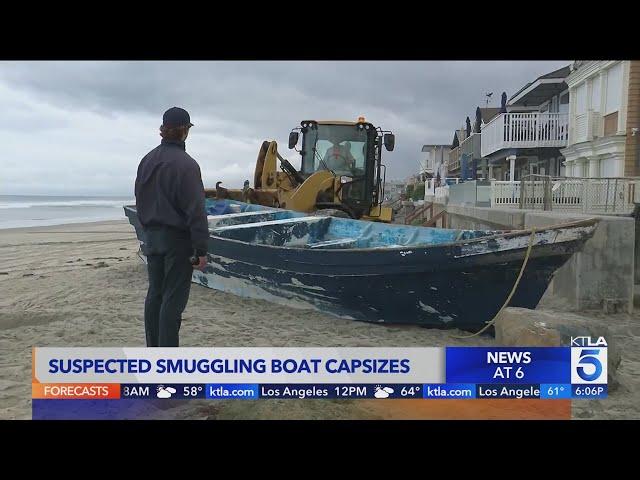Fatal Capsizing of Smuggling Boat Near San Diego Leaves Three Dead, Nine Missing
In a devastating maritime accident off the coast of San Diego, a vessel suspected of human smuggling overturned late Wednesday night, resulting in the confirmed deaths of three individuals and leaving nine others unaccounted for. The U.S. Coast Guard, alongside local authorities, launched an immediate search and rescue mission amid challenging sea conditions. Preliminary reports indicate the boat was transporting undocumented migrants attempting to enter the United States illegally when it capsized due to turbulent waters.
Multiple agencies have coordinated their efforts to locate survivors and investigate the circumstances surrounding the tragedy. Key facts about the incident include:
- Incident Time: Around 11:30 PM local time.
- Vessel Description: A small, motorized craft commonly used in covert smuggling operations.
- Environmental Conditions: Rough seas with strong currents contributing to the capsizing.
- Search Zone: Extensive coastal waters stretching several miles offshore.
| Agency | Role in Response | Current Status |
|---|---|---|
| U.S. Coast Guard | Leading search and rescue operations | Active |
| San Diego Police Department | Investigation and securing the perimeter | Ongoing |
| Immigration and Customs Enforcement (ICE) | Identification and processing of survivors | In progress |
| Emergency Medical Services (EMS) | Providing medical aid and transport | On standby |
Coordinated Search and Rescue Operations Deployed by Coast Guard and Local Agencies
In response to the capsizing, the U.S. Coast Guard and local emergency teams have mobilized extensive resources along the San Diego shoreline to locate the missing passengers. The search covers a broad area several miles offshore, utilizing advanced technology such as thermal imaging drones, high-intensity searchlights, and aerial reconnaissance flights to enhance visibility during nighttime operations. Effective collaboration between federal, state, and local agencies ensures comprehensive coverage and swift reaction to any distress signals or sightings.
To optimize the search efforts, teams employ several strategic methods:
- Deployment of specialized swift water rescue units trained for open ocean recovery.
- Maintaining continuous communication with command centers for real-time updates.
- Use of sonar technology to detect submerged objects and potential survivors.
- Community engagement through alerts encouraging public reporting of debris or unusual activity.
| Unit | Equipment | Primary Function |
|---|---|---|
| Coast Guard Cutter | Radar and Searchlights | Maritime perimeter surveillance |
| Rescue Helicopters | Infrared Cameras | Aerial search and medical evacuation |
| Local Dive Teams | Underwater Sonar | Recovery of submerged victims |
Insights into Smuggling Methods and Routes Revealed by San Diego Incident
Investigations into the recent capsizing highlight the complex and hazardous tactics employed by human smuggling networks operating along the Southern California coast. Smugglers often exploit less-patrolled coastal zones, using overcrowded and poorly maintained vessels to avoid detection. The boat involved reportedly attempted to bypass standard maritime patrols by navigating through shallow waters and narrow passages, significantly increasing the risk of capsizing. The adoption of modern communication devices and GPS technology allows smugglers to alter routes dynamically, complicating interception efforts.
Common strategies observed in these smuggling operations include:
- Utilizing small, agile boats capable of quick maneuvers.
- Conducting operations primarily at night to reduce visibility.
- Deploying decoy vessels to divert law enforcement attention.
- Using multiple drop-off points to disperse migrants and avoid mass apprehension.
| Tactic | Objective | Associated Risk |
|---|---|---|
| Decoy Vessels | Distract authorities | High |
| Nighttime Operations | Minimize detection | Medium |
| Multiple Drop-off Locations | Reduce interception risk | High |
| Fast, Maneuverable Boats | Evade capture | Medium |
Strategies to Enhance Maritime Security and Prevent Future Tragedies
Addressing the risks associated with illegal maritime migration requires a comprehensive strategy emphasizing prevention, swift intervention, and international cooperation. Authorities should expand surveillance capabilities in vulnerable coastal regions by integrating cutting-edge technologies such as unmanned aerial vehicles, advanced radar systems, and satellite tracking. Equipping and training coastal patrol units with modern tools and fostering intelligence-sharing partnerships among neighboring countries will enhance the ability to intercept smuggling attempts before they escalate. Additionally, community outreach initiatives aimed at educating at-risk populations about the severe dangers of unauthorized sea crossings can help reduce reliance on perilous smuggling routes.
Developing a strong legal framework is also critical to deter traffickers and support victims. Recommended measures include:
- Standardizing laws across border nations to ensure uniform prosecution of smuggling networks.
- Boosting search and rescue resources to guarantee rapid response during maritime emergencies.
- Conducting regular joint naval drills to improve coordination and readiness among maritime forces.
- Implementing victim support programs to aid survivors and disrupt cycles of exploitation.
| Initiative | Expected Outcome |
|---|---|
| Upgrading Surveillance Technology | Improved early detection of illicit vessels |
| Enhanced Training and Equipment for Coast Guards | Higher success rates in interdiction efforts |
| Legal Harmonization Across Borders | Consistent enforcement and prosecution |
| Community Education and Outreach | Lower demand for smuggling services |
Conclusion: Reflecting on the San Diego Maritime Tragedy
The recent capsizing of a suspected smuggling vessel near San Diego, which has tragically claimed three lives and left nine individuals missing, highlights the persistent dangers and human toll linked to illegal maritime migration. As authorities continue their search and investigation, the incident underscores the urgent need for enhanced maritime security measures and coordinated efforts to prevent similar disasters. This event serves as a sobering reminder of the complex challenges facing border enforcement and humanitarian response along the U.S. coastline, emphasizing the importance of proactive strategies to safeguard vulnerable populations and uphold maritime safety.







